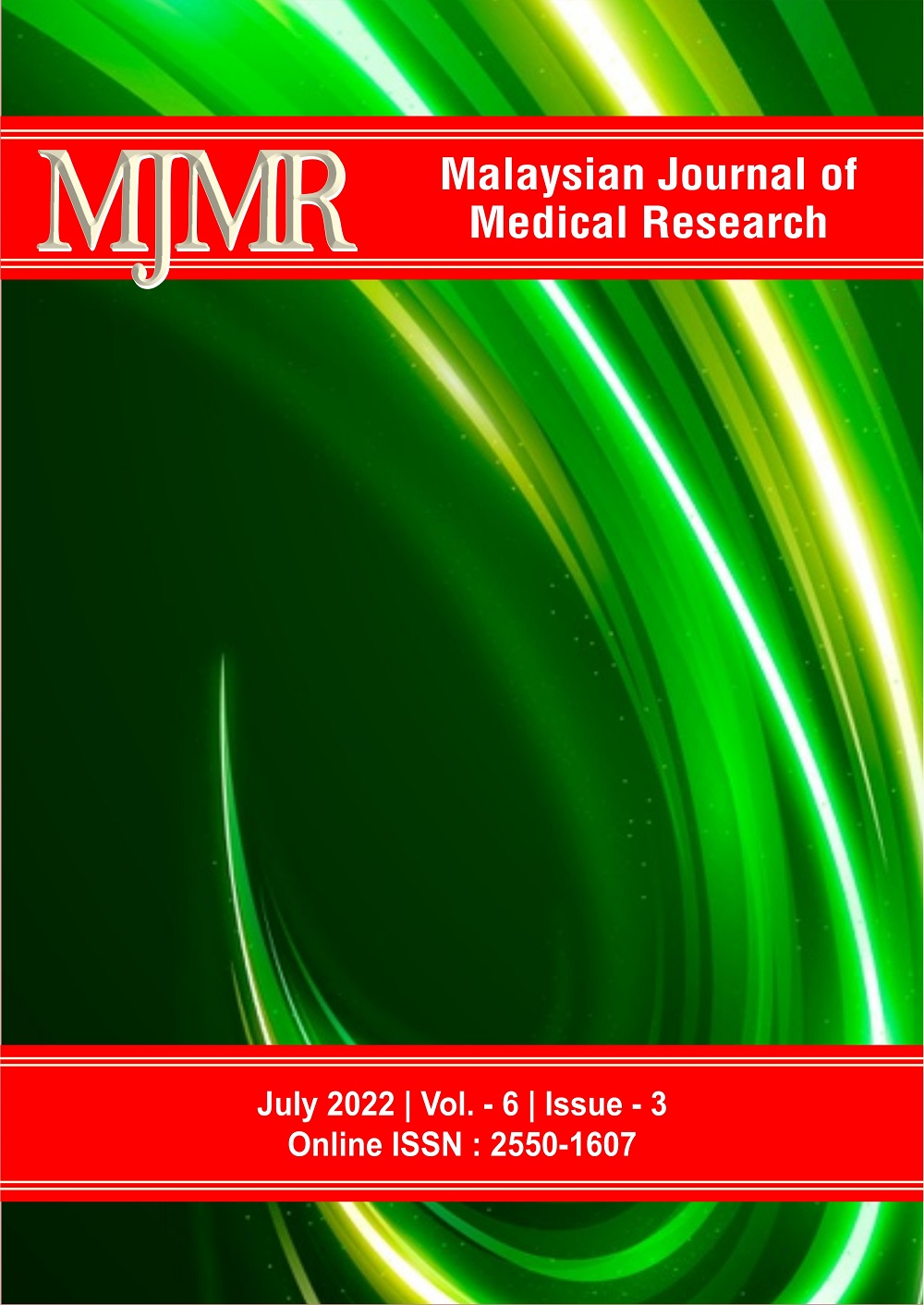Prevalence of Flat Foot in College Going Students: A Cross Sectional Study
DOI:
https://doi.org/10.31674/mjmr.2022.v6i03.005Abstract
Background: A healthy foot is vital for good posture and ambulation. Flatfoot or pes planus is a medical condition defined by the absence or lowered medial longitudinal arch, with Osseo-ligamentous misalignment. The objective of this study was to find out the prevalence of flat foot in college-going students aged between 18 to 25 years by using navicular drop and medial longitudinal arch angle assessment methods. Methods: In this cross-sectional study, 205 volunteers (116 male and 89 female) were assessed for flat foot using Brody’s navicular drop test and medial longitudinal arch angle measurement with an age range of 18-25 years. The navicular drop of ≥ 10mm and medial longitudinal arch angle of < 130° were considered flat feet. Results: The mean age of the total population (n=205) was 23.30 ± 1.63 years. The result of this study showed that when we used the ND test, there was a prevalence of flat foot in 20% of the total population (for males: 21.55%; for females: 17.97%) whereas when we used MLAA measurement, there was the prevalence of 5.36% in total population (for males: 5.17%; for females: 5.61%). Conclusion: The results of this study quantified the prevalence of flat foot in young college-going students. It can be concluded from the result of this study that the prevalence of flat foot in college-going students was 20% when using the navicular drop test whereas 5.61% when using medial longitudinal arch angle measurement.
Keywords:
Flat Foot, Navicular Drop, Medial Longitudinal Arch AngleDownloads
References
Abousayed, M. M., Alley, M. C., Shakked, R., & Rosenbaum, A. J. (2017). Adult-Acquired Flatfoot Deformity: Etiology, Diagnosis, and Management. JBJS Reviews, 5(8), e7. https://doi.org/10.2106/JBJS.RVW.16.00116
Adhikari U, Arulsingh W, Pai G, Raj JO. (2014) Normative values of navicular drop test and the effect of demographic parameters-A cross sectional study. Annals of Biological Research; 5(7):40-8.
Arangio, G. A., Wasser, T., & Rogman, A. (2006). Radiographic comparison of standing medial cuneiform arch height in adults with and without acquired flatfoot deformity. Foot & Ankle International, 27(8), 636–638. https://doi.org/10.1177/107110070602700813
Bandholm, T., Boysen, L., Haugaard, S., Zebis, M. K., & Bencke, J. (2008). Foot medial longitudinal-arch deformation during quiet standing and gait in subjects with medial tibial stress syndrome. The Journal of foot and ankle surgery : official publication of the American College of Foot and Ankle Surgeons, 47(2), 89–95. https://doi.org/10.1053/j.jfas.2007.10.015
Cornwall, M. W., & McPoil, T. G. (1999). Relative movement of the navicular bone during normal walking. Foot & Ankle International, 20(8), 507–512. https://doi.org/10.1177/107110079902000808
Dahle, L. K., Mueller, M. J., Delitto, A., & Diamond, J. E. (1991). Visual assessment of foot type and relationship of foot type to lower extremity injury. The Journal of Orthopaedic and Sports Physical Therapy, 14(2), 70–74. https://doi.org/10.2519/jospt.1991.14.2.70
Deland, J. T., de Asla, R. J., Sung, I. H., Ernberg, L. A., & Potter, H. G. (2005). Posterior tibial tendon insufficiency: which ligaments are involved?. Foot & ankle International, 26(6), 427–435. https://doi.org/10.1177/107110070502600601
Donatelli R. (1995) The biomechanics of the foot and ankle. FA Davis Company.
Ferciot C. F. (1972). The etiology of developmental flatfoot. Clinical Orthopaedics and Related Research, 85, 7–10. https://doi.org/10.1097/00003086-197206000-00003
Footprint Parameters. Journal of manipulative and physiological therapeutics, 41(8), 672–679. https://doi.org/10.1016/j.jmpt.2018.04.001
Harris R I, Beath T. (1949) Army Foot Survey. An Investigation of Foot Ailments in Canadian Soldiers. British Journal of Surgery. 37(146):255. https://doi.org/10.1002/bjs.18003714645
Headlee, D. L., Leonard, J. L., Hart, J. M., Ingersoll, C. D., & Hertel, J. (2008). Fatigue of the plantar intrinsic foot muscles increases navicular drop. Journal of electromyography and kinesiology : official journal of the International Society of Electrophysiological Kinesiology, 18(3), 420–425. https://doi.org/10.1016/j.jelekin.2006.11.004
Jayabandara A, Rodrigo D, Nadeeshan S, Wanniarachchi C, Rajathewa P, Makuloluwa T, Perera D. (2021) Prevalence of Flatfoot and Its Correlation with Age, Gender and BMI among Undergraduates at the Faculty of Allied Health Sciences, General Sir John Kotelawela Defence University. Journal of Pharmacy and Pharmacology.; 9:287-91.
Jonson, S. R., & Gross, M. T. (1997). Intraexaminer reliability, interexaminer reliability, and mean values for nine lower extremity skeletal measures in healthy naval midshipmen. The Journal of Orthopaedic and Sports Physical Therapy, 25(4), 253–263. https://doi.org/10.2519/jospt.1997.25.4.253
Kirmizi, M., Cakiroglu, M. A., Elvan, A., Simsek, I. E., & Angin, S. (2020). Reliability of Different Clinical Techniques for Assessing Foot Posture. Journal of Manipulative and Physiological Therapeutics, 43(9), 901–908. https://doi.org/10.1016/j.jmpt.2020.02.002
Lee MS, Vanore JV, Thomas JL, Catanzariti AR, Kogler G, Kravitz SR, Miller SJ, Gassen SC. Diagnosis and treatment of adult flatfoot. The Journal of Foot and Ankle Surgery. 2005 Mar 1;44(2):78-113. https://doi.org/10.1053/j.jfas.2004.12.001
Nielsen, R. G., Rathleff, M. S., Simonsen, O. H., & Langberg, H. (2009). Determination of normal values for navicular drop during walking: a new model correcting for foot length and gender. Journal of Foot and Ankle Research, 2, 12. https://doi.org/10.1186/1757-1146-2-12
Niki, H., Ching, R. P., Kiser, P., & Sangeorzan, B. J. (2001). The effect of posterior tibial tendon dysfunction on hindfoot kinematics. Foot & ankle international, 22(4), 292–300. https://doi.org/10.1177/107110070102200404
Razeghi, M., & Batt, M. E. (2002). Foot type classification: a critical review of current methods. Gait & Posture, 15(3), 282–291. https://doi.org/10.1016/s0966-6362(01)00151-5.
Shibuya, N., Jupiter, D. C., Ciliberti, L. J., VanBuren, V., & La Fontaine, J. (2010). Characteristics of adult flatfoot in the United States. The Journal of foot and ankle surgery : official publication of the American College of Foot and Ankle Surgeons, 49(4), 363–368. https://doi.org/10.1053/j.jfas.2010.04.001
Smyth, N. A., Aiyer, A. A., Kaplan, J. R., Carmody, C. A., & Kadakia, A. R. (2017). Adult-acquired flatfoot deformity. European Journal of Orthopaedic Surgery & Traumatology : Orthopedie Traumatology, 27(4), 433–439. https://doi.org/10.1007/s00590-017-1945-5.
Spahn, G., Schiele, R., Hell, A. K., Klinger, H. M., Jung, R., & Langlotz, A. (2004). Die Prävalenz von Beschwerden und Deformierungen des Fusses bei Adoleszenten -- Ergebnisse einer Querschnittuntersuchung [The prevalence of pain and deformities in the feet of adolescents. Results of a cross-sectional study]. Zeitschrift fur Orthopadie und ihre Grenzgebiete, 142(4), 389–396. https://doi.org/10.1055/s-2004-822844
Senadheera, S. P., Ekanayake, S., & Wanigatunge, C. (2016). Dietary Habits of Type 2 Diabetes Patients: Variety and Frequency of Food Intake. Journal of Nutrition and Metabolism, 2016, 7987395. https://doi.org/10.1155/2016/7987395
Sung, P. S., Zipple, J. T., Andraka, J. M., & Danial, P. (2017). The kinetic and kinematic stability measures in healthy adult subjects with and without flat foot. Foot (Edinburgh, Scotland), 30, 21–26. https://doi.org/10.1016/j.foot.2017.01.010
Stavlas, P., Grivas, T. B., Michas, C., Vasiliadis, E., & Polyzois, V. (2005). The evolution of foot morphology in children between 6 and 17 years of age: a cross-sectional study based on footprints in a Mediterranean population. The Journal of Foot and Aankle Surgery: Official Publication of the American College of Foot and Ankle Surgeons, 44(6), 424–428. https://doi.org/10.1053/j.jfas.2005.07.023
Van Boerum, D. H., & Sangeorzan, B. J. (2003). Biomechanics and pathophysiology of flat foot. Foot and Ankle Clinics, 8(3), 419–430. https://doi.org/10.1016/s1083-7515(03)00084-6
Pfeiffer, M., Kotz, R., Ledl, T., Hauser, G., & Sluga, M. (2006). Prevalence of flat foot in preschool-aged children. Pediatrics, 118(2), 634–639. https://doi.org/10.1542/peds.2005-2126
Picciano, A. M., Rowlands, M. S., & Worrell, T. (1993). Reliability of open and closed kinetic chain subtalar joint neutral positions and navicular drop test. The Journal of Orthopaedic and Sports Physical Therapy, 18(4), 553–558. https://doi.org/10.2519/jospt.1993.18.4.553
Prachgosin, T., Chong, D. Y., Leelasamran, W., Smithmaitrie, P., & Chatpun, S. (2015). Medial longitudinal arch biomechanics evaluation during gait in subjects with flexible flatfoot. Acta of Bioengineering and Biomechanics, 17(4), 121–130.
Pomeroy, G. C., Pike, R. H., Beals, T. C., & Manoli, A., 2nd (1999). Acquired flatfoot in adults due to dysfunction of the posterior tibial tendon. The Journal of Bone and Joint Surgery. American Volume, 81(8), 1173–1182. https://doi.org/10.2106/00004623-199908000-00014
Tang, C., Ng, K. H., & Lai, J. (2020). Adult flatfoot. BMJ (Clinical research ed.), 368, m295. https://doi.org/10.1136/bmj.m295
Wilkerson, R. D., & Mason, M. A. (2000). Differences in men's and women's mean ankle ligamentous laxity. The Iowa Orthopaedic Journal, 20, 46–48.
Zuil-Escobar, J. C., Martínez-Cepa, C. B., Martín-Urrialde, J. A., & Gómez-Conesa, A. (2018). Medial Longitudinal Arch: Accuracy, Reliability, and Correlation Between Navicular Drop Test and Footprint Parameters. Journal of manipulative and physiological therapeutics, 41(8), 672–679. https://doi.org/10.1016/j.jmpt.2018.04.001
Published
How to Cite
Issue
Section
License
Copyright (c) 2022 Malaysian Journal of Medical Research (MJMR)

This work is licensed under a Creative Commons Attribution-NonCommercial-NoDerivatives 4.0 International License.























